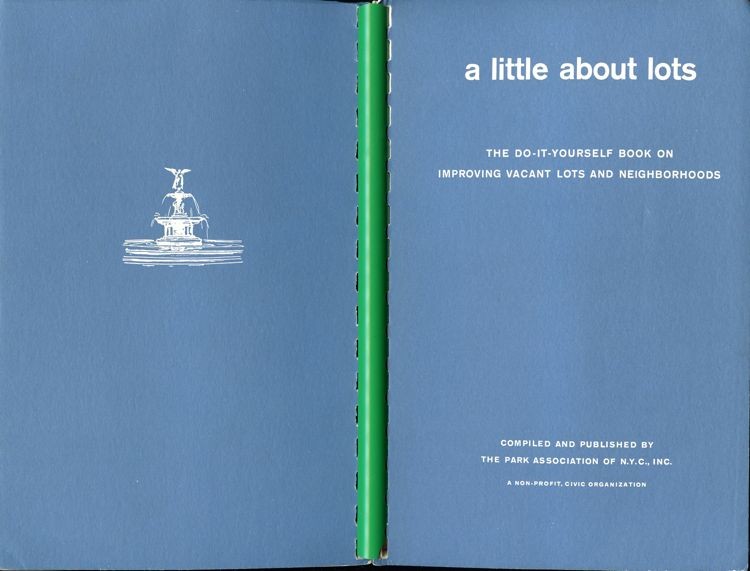a little about lots. The Do-It-Yourself Book on Improving Vacant Lots and Neighborhoods. Compiled and publishes by The Park Association of N.Y.C., Inc., May 1969, 62 p.
The Park Association is New York City’s oldest and largest, private organization concerned with public parks, recreation, open space and neighborhood improvement.
The booklet is a guide for how to transform a vacant lot into a livable space, step by step from how to form a group, raise money, rent the lot and insure it, clean up and plant trees:
Once the lot is available for rent from the public or private owner, arrange for public liability insurance to protect your group from third party liability. The Park Association offers a master vest pocket park vacant lot public liability insurance policy. Before, public liability insurance for vacant lot parks was costly and difficult to obtain.
To obtain this insurance the lot needed to be fenced and locked during night or lighted at night. With moving equipment in it, the lot needs to be fenced. Fencing was then the only way to get the lot insured. Clean-up and keeping the lot clean was another tricky question.
getting people together to help: form a group or join a group to embark upon the vacant lot project. contact local groups to find the interested people, get as many people as possible, seek for people with special skills, name your group
how to raise the big money: organize events (street fair, bazaar, block party) to involve the whole neighborhood.
a little about a lots problems (including vandalism): the best lot is one with two blank walls on either side (otherwise basketball etc is not possible in that part of the lot.) Vacant buildings with unboarded windows are a problem. Vandalism will happen less when everyone in the neighborhood is working on the project. When vandalism happen fix it fast.
keeping it going (Maintenance) maintenance is crucial. The questions to ask: can you afford it and who will be responsible for it? maintenance is a daily task and weekly in winter. Youth groups (a supervision is needed) might be willing to do it for an extra pocket money.
how to design your lot: start small, keep it simple. Do your lot’s „walls“ and „floors“ first, after bring the „furniture“ by leaving some parts free. Think who in the neighborhood will use this space: children, teenagers, elderly people? A „tot lot“ usually includes a sandbox, a „teen lot“ usually includes a basketball-playing area, a „sitting lot“ is for everybody and often includes a planted area. No matter what size your lot is, we suggest that you never try to include all three types of lot in one. The very young and the very old get well together but teenagers need a place of their own.
Let children paint the walls, or let plants climb up. Use home-grown talent and imagination. When you plan a garden, it should be in front of the lot for easy watering. First clean the soil from all broken glass, put a low fence around the garden. Collect the bricks in the neighborhood to build paths (build them when you are sure that no trucks need to drive in the rear part of the lot), to flower your garden, the easiest is to plant bulbs.
posted on August 27, 2013; May 16, 2014; January 9, 2019
